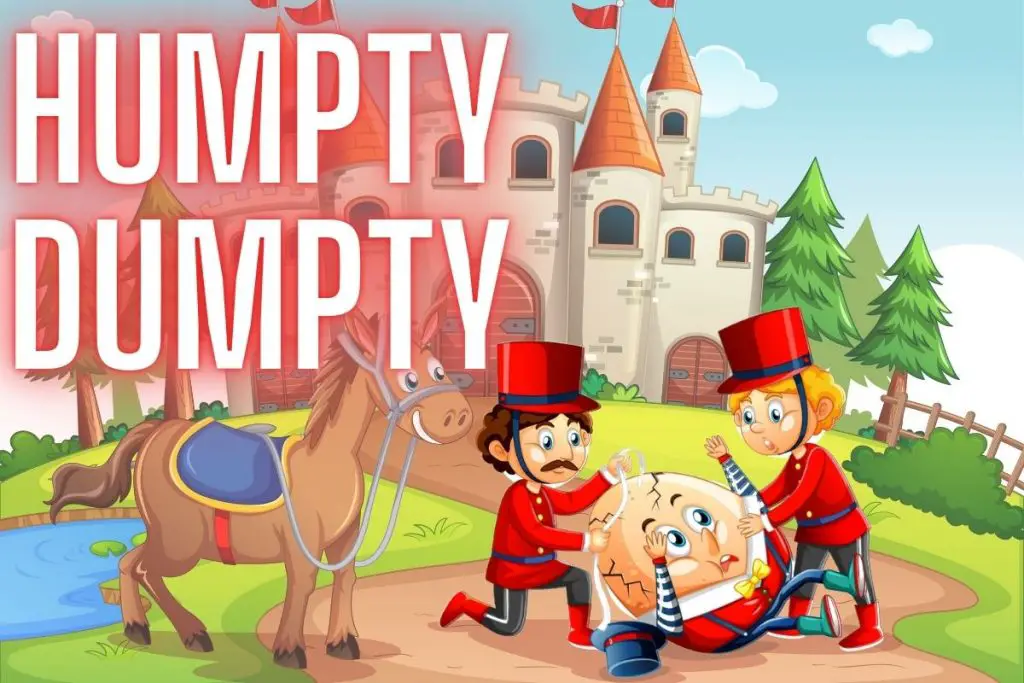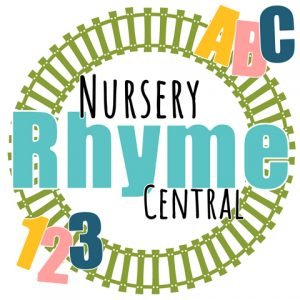Humpty Dumpty is everyone’s favorite egg and the rhyme about him falling off a wall is one of the oldest and most beloved nursery rhymes.

What are the lyrics of Humpty Dumpty?
Modern lyrics
This nursery rhyme is a short, one-verse song. As sung today, the lyrics are as follows:
Humpty Dumpty sat on a wall,
Humpty Dumpty had a great fall.
All the king’s horses and all the king’s men
Couldn’t put Humpty together again.
Original lyrics
However, the rhyme has appeared over time with many different variations. The verse was first published in Juvenile Amusements by Samuel Arnold in 1797, and during this period the world and language used was quite different to that of today:
Humpty Dumpty sat on a wall,
Humpty Dumpty had a great fall.
Fourscore horses and fourscore more
Could not make Humpty where he was before.
Another version from 1803 goes like this – with the original odd spelling:
Humpty Dumpty sate on a wall,
Humpti Dumpti had a great fall;
Threescore men and threescore more,
Cannot place Humpty dumpty as he was before.
An even stranger version from 1842 goes:
Humpty Dumpty lay in a beck.
With all his sinews around his neck;
Forty Doctors and forty wrights
Couldn’t put Humpty Dumpty to rights!
What is the history of Humpty Dumpty?
The original writer of Humpty Dumpty has been lost in the mists of time. What we do know is that the words Humpty Dumpty can be found in a Dictionary for slang written originally by a Frenchman, Sorbier in 1690, and published in English around the same time, but with a totally different meaning to the rhyme, as we know it today, which you can read more about in the next section.
What we also know is that the rhyme was originally a riddle, and the listener was supposed to guess what Humpty Dumpty was: what could fall off a wall and not be put back together, no matter what you did? If you think about it, there is nothing in the rhyme that describes him as an egg. Today, because Humpty Dumpty is usually pictured as a giant anthropomorphized (human-like) egg, the verse has become a children’s song, no longer a riddle.
There are also historical stories that Humpty Dumpty was the name given to a cannon used at the siege of Colchester in the Second Civil War in 1648. According to a well-researched article by Robert Hodkinson, during the Siege the cannon fell from the city. The steeple it had been placed in was not strong enough to withstand the blast and it came tubmling down, collasping the tower and killing the gunner. This story and history was only written down during the mid-eighteenth century from stories and tales from the locals in colchester and no mention was made to Humpty Dumpty in the writing.
There is also a link to another battle in Gloucester in 1643, made quite recently by Professor David Daub in 1956, but the histories show no mention of ‘Humpty Dumpty’ in them and so many believe his theory to be more speculation based on opinion rather than supported by facts or research.
Versions of the Humpty Dumpty riddle appear in many other languages, such as Boule, boule in French, Thille Lille in Swedish, Lille-Trille from Denmark, Hillerin-Lillerin in Finnish, Annebadadeli from Switzerland, and Trille Trolle, Etje-Papetje, Wirgele-Wargele, Gigele-Gagele, Runtzelken-Piintzelken, and Humpelken-Piimpelken from different parts of Germany.
There is not much known about the origins of the musical melody behind the words of Humpty Dumpty. It was first published by the composer James William Elliot in 1870 in his compilation – National Nursery Rhymes and Nursery Songs.
WHAT DO THE WORDS MEAN? DEFINITIONS:
What is a humpty dumpty?
When the riddle was first heard of in the seventeenth century, a “humpty dumpty” was a drink made from brandy boiled with ale. However, “humpty dumpty” was also slang for a clumsy, oafish person (how you’d behave after drinking too many humpty dumpties!). So, the original riddle writer assumed that people would know this slang and that a clumsy person falling off a wall wouldn’t break into pieces. So, a humpty dumpty must mean something else that the listener must guess – what would break into so many pieces that it could never be put back together again?
Today, the term “humpty dumpty” refers to a situation that is irretrievable, something that has gone completely wrong and cannot be put right again.
Why is an egg sitting on a wall?
One explanation is that this is part of the riddle – no egg could survive falling from a wall. However, Peter and Iona Opie, the great historians of English nursery rhymes, explain that the puzzle used to be paired with a game. In the game, little girls (the eggs) would sit in a row on a make-believe wall, holding their skirts down tightly. Then, they would throw themselves backward, with the aim being to recover their balance without letting go of their dresses. Another game could be when a child is bounced on an adult’s knee and then drops down when the egg falls. As the Opies explain in their Oxford Dictionary of Nursery Rhymes, “Eggs do not sit on walls, but the verse becomes intelligible if it describes human beings who are [im]personating eggs.”
Why are the king’s horses and men trying to fix Humpty Dumpty?
Again, this rhyme was intended as a riddle so it will be a little nonsensical. However, when the verse was created, the most powerful person in England was the king, so if something was beyond the king’s armies’ power, it was impossible. If all the king’s horses and men couldn’t do something, then nobody could. Many people have tried to assert from these phrases that the rhyme was therefore created about a king, but most of those stories have been disregarded as you will read below!
Interesting facts and questions answered
Is Humpty Dumpty a character in Alice in Wonderland?
The nursery rhyme Humpty Dumpty was well-known by the time Lewis Carrol wrote Alice in Wonderland (1865). So, the nursery rhyme character, the well-dressed egg sitting on a wall, appears in the sequel to Alice in Wonderland, called Through the Looking Glass (1871). Alice meets Humpty Dumpty, and they argue about whether he is an egg or whether he simply looks like one, and whether he is wearing a cravat (around his neck) or a belt (around his waist).
Is Humpty Dumpty a villain in Batman comics?
Humpty Dumpty also makes other appearances in fiction, including as a villain in Batman. Humphry Dumpler is a character with an egg-shaped head whose villainy only extends to speaking in rhyme and fixing anything he perceives as broken. Although not the evilest villain, he ends up in Arkham Asylum.
Is Humpty Dumpty based on a person from history?
The historian Katherine Elwes Thomas stated in 1930 that Humpty Dumpty refers to the English King Richard III, who was defeated and killed at Bosworth Field in 1485 despite having a massive army of men and horses. Popular history states that Richard was a hunchback or humpback, hence the reference to his “hump”; however, Richard III’s skeleton shows that he was not a hunchback, nor was the term humpback used at the time.
Punch magazine of 1842 suggested that Humpty Dumpty is about the downfall of Cardinal Wolsely, whom England’s King Henry VIII refused to be allowed to be buried in his tomb because he was displeased with the Cardinal. However, Cardinal Wolseley was never called Humpty Dumpty – and the article was intended as a joke.
Was Humpty Dumpty murdered?
The nursery rhyme doesn’t say whether Humpty Dumpty jumped, fell by accident, or was pushed. But in Jasper Fforde’s The Big Over Easy (2005), Detective Inspector Jack Spratt investigates the murder of Humperdink Stuyvesant von Dumpty III, who is – you’ve guessed – a giant egg.
Is Humpty Dumpty public domain?
Yes, Humpty Dumpty is a public-domain song. This means that no one has the copyright to it and that if you want to use the song in your work you can. (Disclaimer: This is a general – not a legally confirmed fact and you need to do more research into the laws in your jurisdiction/country to confirm you have the right to use this song)
Basically anything published or copyrighted before 1925 today is considered public domain.
BUT this does not apply to other people’s versions of it – for example, if you made a CD of you singing Humpty Dumpty, your version is not public domain, I cannot resell it.
Humpty Dumpty inspired Lesson Plans
The following are a selection of Lesson Plans that I have found that are inspired by the Humpty Dumpty Nursery Rhyme. All of the lessons are hosted by other websites so you will need to click on the images to learn more and download their resources.
Sheet music
Humpty Dumpty was originally a riddle, not a song. However, in 1870, James William Elliot, a composer, published the rhyme with its melody in his collection of National Nursery Rhymes and Nursery Songs. Today you can find the sheet music in various forms based on the same melody created back in 1870.
What time signature is Humpty Dumpty played in?
Humpty Dumpty is played in 6/8 time. This means that there are 6 quavers or eighth notes to each bar. It is easier though when singing or counting each measure with children to count in threes, 1 2 3, 1 2 3 like a waltz because the counts would otherwise be too fast and complicated for little ones to follow. But if you were to play the music with an instrument you would be counting 6 quaver beats or eighth notes to every bar!
What musical Pattern does Humpty Dumpty have?
Humpty Dumpty follows an AABB rhyming pattern where wall and fall rhyme and then men and again also ryhme, like couplets in poetry. There is also the pattern of stressed and unstressed syllables that Humpty Dumpty follows called the poem trochaic tetrameter. This means there are four stressed syllables in each metre or phrase which is common in nursery rhymes and I have bolded the rhyme below to show you where the stresses occur.
Humpty Dumpty sat on a wall,
Humpty Dumpty had a great fall.
All the king’s horses and all the king’s men
Couldn’t put Humpty together again.
How to play Humpty Dumpty on a musical instrument
Because Humpty Dumpty is such a short, simple melody, it is suitable for beginners learning to play the guitar, piano, recorder, or marimba.




